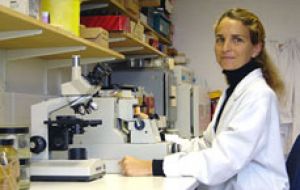MercoPress. South Atlantic News Agency
Deep sea abyss swamped with diversity of life and new species
 Ten years of research unveiled 17.650 species untouched by sunlight
Ten years of research unveiled 17.650 species untouched by sunlight From a translucent giant octopus to a fish bearing barbed fangs, a team of international scientists say they have discovered hundreds of new species living in total darkness at least 5km beneath the surface of the world's oceans.
Nearly 17,650 species of animal, including corals, crabs and starfish, were identified living in the depths untouched by sunlight, a marine survey found.
The findings, made public on Monday, were the result of nearly 10 years of research by more than 2,000 scientists from 80 countries taking part in the first global census of marine life.
Robert Carney, an oceanographer at Louisiana State University, who co-leads the study of the ocean depths as part of the wider International Census of Marine Life (COML) said, “The diversity of life in the deep sea is much, much greater than we believed. The abyss is not the dark hole anymore,” he said.
The researchers discovered 5,600 new marine species on top of the 230,000 animals already known to live in the world's oceans and they hope to add several thousand more when the final census is released in London on October 4, 2010.
Scientists predict that there could be more than one million species which remain undiscovered.
“The reality is that the deep sea is a frontier that hasn't been studied very much, but with modern technology and still after 10 years we've only scratched the surface of this huge environment” said Aksel Bergstad, an oceanographer based at the University of Bergin in Norway.
Among the creatures identified in the deep sea areas were luminous jellyfish and gelatinous creatures known as finned octopods, or “dumbos,” because they flap earlike fins and look like the cartoon elephant.
“Most of the organisms in the deep sea depend on the steady rain and transport of material from the sunlit upper layers and this comes in many forms from small organic particles and dead animals,” Bergstad said.
“But one of the main problems for all these deep sea creatures are the scarcity of food, the darkness and the huge volumes they have to cope with. However, these animals are uniquely adapted”.
Experts also found a tubeworm at a depth of 990m on the seafloor in one part of the Gulf of Mexico. After using a robotic arm to lift the tubeworm from a hole on the seabed, oil gushed out and they discovered it was consuming chemicals from the decomposing oil.
Carney said that oil companies focused mostly on geological surveys to find deposits but that the presence of tubewarms could also be a marker.
“You certainly have a source or methane or liquid petroleum nearby if you find these tubeworms,” he said.
Another trip to the seafloor of Antarctica recorded the Osedax, a whalebone-eating worm. Although the ocean depths are permanently black, many animals create their own light with luminous markings to help spot or attract prey or a mate. Scientists also said many have working eyes.
A few creatures that normally live in the sunlit zone visit the abyss, such as the southern elephant seal which was registered at a depth of 2,388m.




Top Comments
Disclaimer & comment rulesCommenting for this story is now closed.
If you have a Facebook account, become a fan and comment on our Facebook Page!